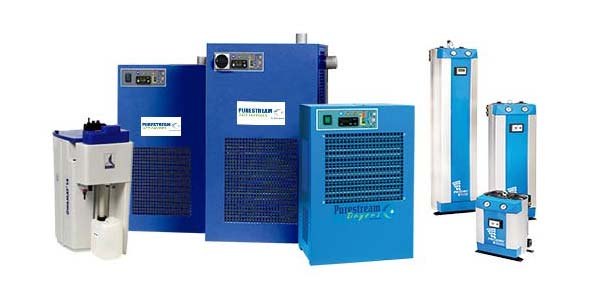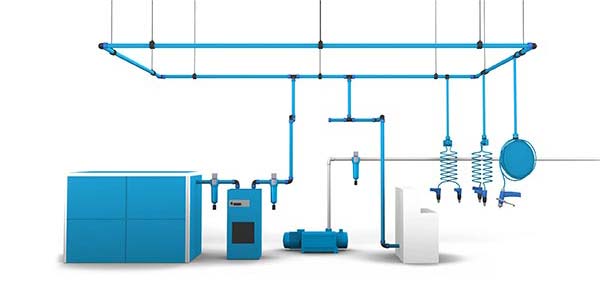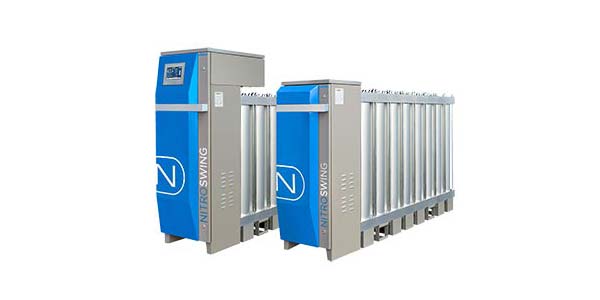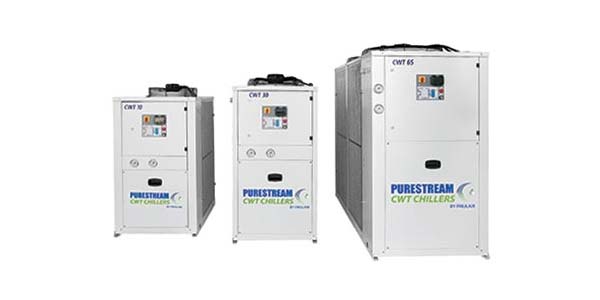System Problems & Solutions for Process Chillers
Problem with your system? We have the solution.
Process cooling systems can experience a variety of challenges and CAG Technologies specializes in reliable solutions to help you better manage your process throughout your facility, effectively and efficiently. In order to assist you in solving your process cooling system challenges, we have listed some of the most common problems users experience on a regular basis. Take a tour of our list of the typical problems that Plant Managers/Operators experience and review recommended solutions that we have provided. Feel free to contact us for more detailed solutions, to schedule a jobsite visit, or to come see one of our chillers at our CAG Mississauga Chiller Centre (CMCC).
- Most Recirculating chillers we find in the industrial space tend to be greatly oversized, but if your chiller is undersized it will tend to not be able to cool the water sufficiently and hence unable to deliver the cooling water/glycol at the setpoint required. There is often a mismatch in flow vs temperature in existing systems, and it is important to understand the relationship and the machinery you are trying to cool.
- Many systems are transferring over from City Water where the flow or discharge temperature was not a concern. Understanding what the real heat load across a machine is... on the hottest day, is an important part of selecting the right recirculating chiller system.
- Refrigeration system effectiveness tends to go down over time which means maintenance and service are important. If your chiller used to meet your needs and now doesn't, it is time to investigate and repair or replace.
- Ambient Temperatures are going up and selecting the right chiller at the correct ambient temperature is important, especially on Indoor Chillers. Always make sure you check selection and catalog data (fine print) to verify the ambient temperature the data is based on. A 5 Ton chiller in April is not a 5 Ton Chiller in July. Your least amount of capacity is when you have the highest demand. Trust CAG Technologies to select the right chiller... everytime... It is our guarantee.
- With 20+ years in the process cooling business CAG Technicians know the Hot Water Sandwich is one of the worst problems to encounter. It happens when the load drops off or is very variable, causing the chiller to cycle off the single stage compressor. Most compressors have a 5 minute off-cycle and will not restart until that time has elapsed. Meanwhile the recirculating pump is still circulating Cold-Hot-Cold. This leads to failed molded parts and unstable operation of the machinery being cooled.
- Modern chillers like Purestream CWT/QBE have properly designed Buffer Tanks, Low Load Stability Packages and special compressors that cycle off only 3 minutes. On our CWT series we employ multi-compressors for stable, efficient operation to match your needs. A larger capacity chiller is very rarely better in the long run. A properly sized dynamic process chiller is the best bet.
- In the Canadian market the differences in Winter Temperature varies greatly with the geographical location. When a chiller is to be placed outside, the first thing our consultants will ask is "What is the final location". As the Ambient Temperature drops, the amount of airflow required across the condenser is decreased. A Chiller that is designed for Winter Operation is a Dynamic chiller, and not a Summer Operation or Air Conditioning Chiller. It is always best to chose a manufacturer that specializes in process and dynamic chillers as a standard air conditioning duty chiller will most likely not have the temperature range or operation range required and at all temperatures. CAG typically supply Winscreens or Wind Baffles to help with nuisance shutdowns due to wind effect/chill.
- In Canada you have some choices to make when it comes to Indoor or Outdoor Chillers.
Key Points to ponder
- Indoor Packaged Chillers allow you to use Fresh Water or lower glycol concentration than outdoor. In the winter time you can keep that heat inside the building by using an Indoor Chiller. A 10 Ton Chiller operating inside in the winter will provide 144000 BTUH to the space replacing the operation of Unit Heaters and Tube Heaters. When combined with Destratification fans, they can be a very efficient way to heat your space.
- Outdoor chillers require the use of 40-50% Glycol Antifreeze to operate in the winter time which derates heat transfer performance. You must also now ideally use a pressurized closed loop chiller. An Outdoor Chiller requires Low Ambient Control of the condenser fans which are typically more expensive. Installed Location of the chiller on the roof or ground is an important factor to reliable winter operation.
- One of the biggest drawbacks to placing chillers outside on the ground is theft and vandalism due to the copper and aluminum components in the units. We recommend they be fenced in with Bollards to prevent vehicles/forklifts from hitting the chiller. Rooftop locations should have a remote panel and the weight of the water tank taken into account for roof re-enforcement. Chiller air intakes should be located out of the prevailing wind.
- Many small to medium sized manufacturers now use a portable 5-30 Ton chiller inside in the winter and move it outside (on wheels) in the summertime. This can be a very cost effective and an energy saving solution to winter heating bills and managing indoor temperatures inside the space during the summer. Also if you move or upgrade, you can take your chiller with you or sell it. There is a strong market for used chillers so a permanent chiller is not always the best choice. Portable chillers are very flexible for small/medium size manufacturers and the resale is often overlooked.
- Indoor Ducted Chillers is another option but proper sheetmetal design is vital if using propeller discharge fans. Space pressurization/Makeup Air is also a consideration if exhausting a high amount of air. Blower style or specialized propeller fans should be used for closed ducting but tend to be more expensive than a standard indoor chiller.
- Split systems (Indoor section/Outdoor section connected by refrigeration piping) can be an effective solution when properly designed by a refrigeration piping expert and involve the use of a licensed contractor and the installation is permanent. Typically the highest capital cost of all the options and finding a contractor these days can be difficult with Trade Staff shortages.
- If your current loop is closed (no openings to atmosphere) then you can typically use an off the shelf packaged recirculating chiller. However if your current system has an atmospheric component such as an open reservoir or cooling troughs then your system is "open" Packaged chillers can be incorporated into open systems but may be a more customized solution and the Fluid Mechanics of your system need to be reviewed to make the system work properly. Many 1970s and 1980s era process cooling systems integrate large open reservoirs with complex refrigeration systems and controls. The technologies available today like Microprocessors, Multi-Scroll and VSC Compressors make this old design inefficient, costly and complex and difficult to replace or repair. A simple "in a box solution" should always be reviewed first.
- Many Indoor Portable chillers tend to be Air-cooled but larger manufacturers and those with a centralized Cooling Tower or Fluid cooler may prefer a water-cooled approach. There are benefits to both and it is typically a decision that is based on the scale of cooling required and system efficiency.
- Manufacturers that use City Water to cool chillers or equipment are quickly seeing that it is no longer economically feasible to cool this way as municipalities are targeting this practice. Check with your town/city, they may be offering incentives for you to stop dumping heat down the drain and conserving water.
- A Pressurized Chiller Tank is great for permanent installations or seasonal changeover systems as well as Outdoor Installations Once the system is charged with Glycol /Water the loop is sealed and unless the system leaks you should not have to add makeup or replacement water. When the pump shuts off the loop still retains pressure.
- Most Portable Indoor Chillers use a Non-Pressurized Storage tank which means Pressure is lost at the storage tank on the return to the chiller. These are ideal for plastic applications where there are mold changes as when the chiller is off there is little pressure in the lines so disconnecting and connecting is easier. Any Water Loss can easily be added back at the chiller which has a level indicator showing the tank level.
- Consult with CAG Application Team to review the best option for your process and also come by and see the differences in chillers before you buy.
- If you have a Pressurized Buffer tank you will require an adjustable Bypass in most cases and it is included on most of our chiller line up to 35 Ton. In a Non- Pressurized Chiller with Storage Tank a Manual bypass between the supply and Return is required to balance Temp vs Flow in cases where the same chiller may be used on different loads. CAG installs a Bypass Valve internally with the Hand Operated Valve accessible from the outside of the unit.
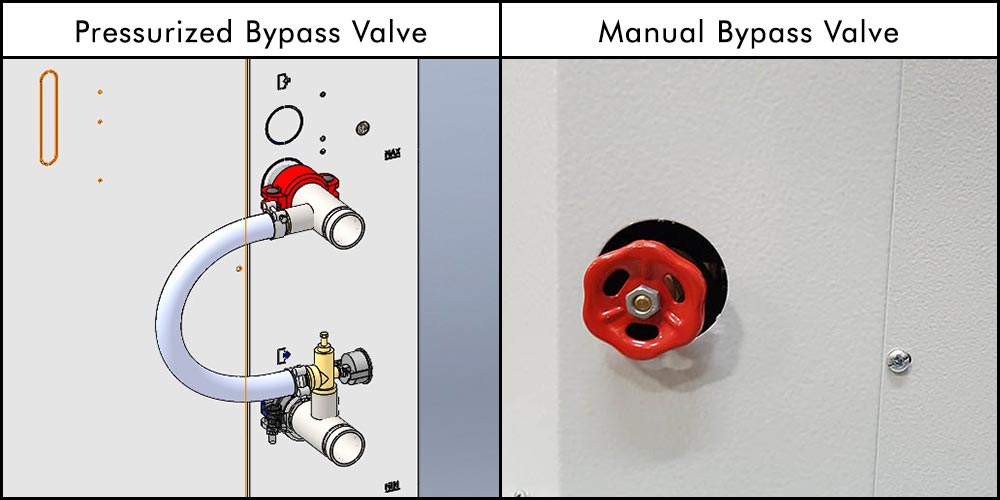
- CAG Tech prides itself in stocking common sizes of Recirculating Chillers and in different configurations to provide "off the shelf" solutions. Typically, an off the shelf solution will be the most cost effective and offer the quickest delivery available on the market. Chillers can fail on some of the hottest days of the year and it's good to know CAG will have something in stock to get you back up and running quickly.
- CAG also builds custom packaged chillers for all types of specialty applications and dynamic process cooling requirements. Consult a CAG Application Specialist to review best options.
- When CAG launched the "Chill-Cube" series in 2017 it quickly became the standard for industry excellence for small flexible recirculating chillers. A Microprocessor operated, compact chiller package, with Vertical Air Discharge was what industry and OEM partners wanted and we delivered. The standard unit comes with;
- Low Load Stability Package to prevent Cycling of the single Compressor and allow operation to 50%.
- Non-Pressurized Storage Tank with Water Level Window.
- Manual bypass Valve adds flexibility and the ability to dial the chiller in to your application or match different loads.
- We view this style of chiller as "an appliance" and after watching our short videos, you can easily install yourself and call one of our Technical support Specialists for Assistance if you require help.
- Many clients are looking to replace an existing system that has failed or is failing. From an efficiency and environmental stand-point you should first look at a more modern solution. As mentioned above, built up component driven refrigeration systems with archaic Controls are obsolete, too complex, and the Technicians able to service such designs dwindles every year.
- Contact CAG and look at a dynamic cooling machine in a box. Hook up your piping, electrical, fill the tank and set your temperature. In most cases, specialized Trades are not required and in-house talent can install. On larger chillers, CAG will be there to review the install and Commission the unit.
- Depending on the model our chillers can deliver down to -10°C Glycol. We will often pair a Recirculating Chiller with a carefully selected Plate and Frame or Cleanable Shell and Tube Heat Exchanger. This allows us to cool any liquid. Most common are Hydraulic oil, Cutting Oil, Incoming Potable city Water etc. CAG has often provided the complete kit of hoses, heat exchange and chiller to give you a Plug and Play solution that you can install yourself.
- One of the most overlooked solutions in Process Cooling is "Immersion Cooling with Glycol" Similar to the Remote Heat Exchanger we are now using "Indirect Cooling". You can add a coil of copper or stainless steel tubing to an existing Tank. Tie that Coil back in a closed loop to the chiller, fill with Glycol and now you have a Tank cooler. We have used this solution in many different situations to add cooling in a process.
- Bring your applications, we love a challenge at CAG Tech.
- Outdoor systems require typically 40% Glycol to prevent Freezing. Modern Inhibited Glycols like Ethylene and Propylene also prevent corrosion and Anti-Microbial Growth in the loop. Most of the Indoor chillers we sell are Non-Ferous ( no rusting) but the external loop may have Iron components, it is never a bad idea to add Inhibited Glycol to your Indoor system. Disodium Phosphate can also be added to non-pressurized tanks to prevent Ant-Microbial Growth in Cooling Loops.
- CAG will often provide PG or EG Glycol. Consult with our Application Specialists for recommendations for your system.
- This is a common problem where a chiller package is coming as part of a system from another country. If you are ordering a system from overseas or even the USA, make sure you ask about the electrical approvals on the Chilling unit component of the system. CAG can provide an equivalent unit, usually from stock, that will meet your requirement and have all the necessary approvals. Often an OEM will ship a piece of machinery without the chiller and you can provide one from CAG with Canadian approval.
- Please call 1-800-951-0777 and ask for Technical Support. You will need the model and Serial # of your chiller. CAG Technologies will typically have any parts required in stock for immediate shipment or pickup.
- As companies grow they often outgrow their equipment and upgrade to larger systems and todays Digital Marketplace allow for Resale and Repurposing of all sorts of industrial equipment. Packaged Chillers are a product that retain their value in the marketplace. CAG Technologies sells high quality Italian Built Chillers with local Parts and Service. It is an important benefit to packaged solutions, that they have residual value and well-made equipment with parts availability holds it value best.
- A Packaged Chiller is a combination of Complex Refrigeration Components with High Volume Fans, Compressors with a Hydronic system ( Pump, Tanks, Sensors etc) that is often working 365 days a year for 12-24 hours/day. It is mechanical equipment and needs to be maintained. One of the most important aspects is monitoring Refrigerant Pressures to spot a leak before it damages the system. Air Filters should be cleaned on a regular basis with scheduled coil cleaning when required. Coil Cleaning greatly increases efficiency and prevents stress on Condenser Fans. A Maintenance Plan can be purchased with your chiller or at a later date. If you need service on a CAG/Friulair Chiller call 1-800-951-0777 and ask to speak with Service Department.
Welcome to CAG Technologies
What can we help you with today?
Please choose from one of our product categories below and one of our technical specialists will assist you promptly.
